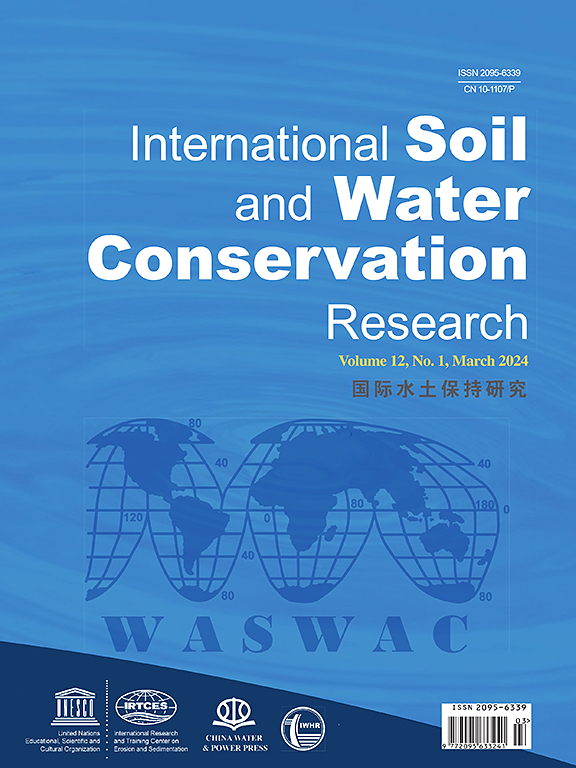Seasonal variation in soil erosion resistance of gullies covered by different plant communities on the Loess Plateau of China
IF 7.3
1区 农林科学
Q1 ENVIRONMENTAL SCIENCES
International Soil and Water Conservation Research
Pub Date : 2025-03-12
DOI:10.1016/j.iswcr.2025.03.002
引用次数: 0
Abstract
Vegetation growth can effectively alter near soil surface characteristics of plant communities, which is likely to impact the seasonal variation in soil erosion resistance of gullies, particularly in semi-arid and arid regions. However, few studies have been focused on quantifying the temporal variations in soil erosion resistance of gullies restored with different vegetation communities at the seasonal scale. This study investigated the seasonal variation in soil erosion resistance of gullies covered by five different plant communities on the Loess Plateau. The experiment was conducted 7 times from 15 May to October 4, 2023 at an approximately 3-week interval. For each time, 90 natural undisturbed topsoil samples were carefully collected from the bottom, left, and right banks of each gully. The collected samples were subjected to scouring under different hydraulic conditions to measure soil detachment capacity and then to determine soil erosion resistance, reflected by rill erodibility (Kr) and soil critical shear stress (τc). Near soil surface characteristics of plant community were also measured at the same sites with an identical frequency. The results showed that soil erosion resistance differed significantly for gullies covered by different plant communities. The mean Kr of grass communities was 0.17 m s−1, which was 47.8 % and 30.6 % to that of shrub and forest communities, respectively. The mean τc of grass communities was 1.45 and 1.26 times that of shrub and forest communities. During the vegetation growth season, soil erosion resistance of gullies covered by different plant communities increased gradually. The seasonal variations in soil erosion resistance were dominantly influenced by the temporal changes of soil cohesion (Coh), soil penetration resistance (PR), water stable aggregate (WSA), and root mass density (RMD). Kr decreased exponentially with Coh and WSA, and logarithmically with PR and RMD, while τc increased linearly with these four factors. Rill erodibility could be well estimated by Coh, PR, WSA, and RMD (R2 = 0.91, NSE = 0.91). The results are conducive to insight into the seasonal variation in erosion of relatively stable gullies covered by vegetation in semi-arid regions.
黄土高原不同植物群落覆盖沟壑区土壤抗侵蚀能力的季节变化
植被生长可以有效地改变植物群落近土表面特征,从而可能影响沟渠土壤抗侵蚀能力的季节变化,特别是在半干旱和干旱区。然而,在季节尺度上,对不同植被群落修复的沟沟土壤抗侵蚀能力的时间变化进行量化研究较少。研究了黄土高原5种不同植物群落覆盖沟壑区土壤抗侵蚀能力的季节变化。实验于2023年5月15日至10月4日进行了7次,间隔时间约为3周。每次,从每个沟壑的底部、左岸和右岸仔细收集90个未受干扰的自然表土样本。在不同的水力条件下,对所收集的样品进行冲刷,测量土壤的剥离能力,然后通过细沟可蚀性(Kr)和土壤临界剪应力(τc)来确定土壤的抗侵蚀能力。在同一地点以相同频率测量了植物群落近土壤表面特征。结果表明,不同植物群落覆盖沟渠的土壤抗侵蚀能力存在显著差异。草木群落的平均Kr为0.17 m s−1,分别为灌丛和森林群落的47.8%和30.6%。草木群落的平均τc分别是灌木和森林群落的1.45倍和1.26倍。在植被生长季,不同植物群落覆盖沟渠的抗侵蚀能力逐渐增强。土壤抗蚀性的季节变化主要受土壤黏聚力(Coh)、土壤渗透阻力(PR)、水稳性团聚体(WSA)和根系质量密度(RMD)的时间变化影响。Kr随Coh和WSA呈指数递减,随PR和RMD呈对数递减,τc随这4个因子呈线性递增。Coh、PR、WSA和RMD可以很好地估计细沟的可蚀性(R2 = 0.91, NSE = 0.91)。研究结果有助于了解半干旱区植被覆盖的相对稳定沟渠侵蚀的季节变化规律。
本文章由计算机程序翻译,如有差异,请以英文原文为准。
求助全文
约1分钟内获得全文
求助全文
来源期刊

International Soil and Water Conservation Research
Agricultural and Biological Sciences-Agronomy and Crop Science
CiteScore
12.00
自引率
3.10%
发文量
171
审稿时长
49 days
期刊介绍:
The International Soil and Water Conservation Research (ISWCR), the official journal of World Association of Soil and Water Conservation (WASWAC) http://www.waswac.org, is a multidisciplinary journal of soil and water conservation research, practice, policy, and perspectives. It aims to disseminate new knowledge and promote the practice of soil and water conservation.
The scope of International Soil and Water Conservation Research includes research, strategies, and technologies for prediction, prevention, and protection of soil and water resources. It deals with identification, characterization, and modeling; dynamic monitoring and evaluation; assessment and management of conservation practice and creation and implementation of quality standards.
Examples of appropriate topical areas include (but are not limited to):
• Conservation models, tools, and technologies
• Conservation agricultural
• Soil health resources, indicators, assessment, and management
• Land degradation
• Sustainable development
• Soil erosion and its control
• Soil erosion processes
• Water resources assessment and management
• Watershed management
• Soil erosion models
• Literature review on topics related soil and water conservation research
 求助内容:
求助内容: 应助结果提醒方式:
应助结果提醒方式:


